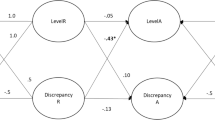Abstract
Data from 33 cohabiting couples are analyzed from a conflict theory perspective. Commitment balance in a cohabiting relationship (i.e., equal commitment to the relationship rather than one partner valuing it more) is found to be important in understanding conflict processes. Five hypotheses are developed from this theoretical perspective and these findings.
Similar content being viewed by others
References
ARCHIBALD, J. (1976) “Face to face: the alienating effects of class, status, and power division.” Amer. Soc. Rev. 41: 918–937.
BACH, G. and R. DEUTSCH (1974) “Conflict: the key to sustained reality,” pp. 182–200 in C. Williams and J. Crosby (eds.) Choice and Challenge. Dubuque, IA: William C. Brown.
CHAFETZ, J. (1980) “Conflict resolution in marriage.” J. of Family Issues 1: 397–421.
COLE, C. (1977) “Cohabitation in social context,” pp. 62–79 in R. Libby and R. Whitehurst (eds.) Marriage and Alternatives. Glenview, IL: Scott Foresman.
DEUTSCHER, I. (1973) What We Say/What We Do. Glenview, IL: Scott Foresman.
FRANK, E., D. ANDERSON, and D. RUBENSTEIN (1980) “Marital role ideas and perception of marital role behavior in distressed and non-distressed couples.” J. of Marriage and Family Therapy 6: 55–63.
GOULDNER, A. (1960) “The norm of reciprocity: a preliminary statement.” Amer. Soc. Rev. 25: 165–167.
HENNON, C. B. (1980) “The management of conflict and interpersonal violence by cohabiting couples.” (unpublished)
—— and C. L. COLE (1981) “Role strain and stress in split-shift relationships.” Alternative Lifestyles 4 (May): 142–155.
HENNON, C. B. and B. J. WELLS (1981) ‘Non-marital cohabitation research reviewed and organized by use of open system framework.” Prepared for Groves Conference on Marriage and the Family, Mt. Pocono, PA.
HOMANS, G. (1961) Social Behavior: Its Elementary Forms. NY: Harcourt Brace Jovanovich.
MACKLIN, E. (1978) “Non-marital heterosexual cohabitation.” Marriage and Family Review 1: 1–12.
SCANZONI, J. (1972) Sexual Bargaining: Power Politics in the American Marriage. Englewood Cliffs, NJ: Prentice-Hall.
SCHELLING, T. (1963) The Strategy of Conflict. New York: Oxford Univ. Press.
SKIPPER, J. and G. NASS (1966) “Dating behavior: a framework for analysis and an illustration.” J. of Marriage and the Family 28: 412–420.
SPREY, J. (1969) “The family as a system in conflict.” J. of Marriage and the Family 31: 699–706.
STOLTE, J. (1978) “Positional power and interpersonal evaluation in bargaining networks.” Social Behavior and Personality 6: 73–80.
WALLER, W. (1937) “The rating and dating complex.” Amer. Soc. Rev. 2: 727–734.
Author information
Authors and Affiliations
Rights and permissions
About this article
Cite this article
Hennon, C.B. Conflict management within cohabitation relationships. J Fam Econ Iss 4, 467–486 (1981). https://doi.org/10.1007/BF01094177
Issue Date:
DOI: https://doi.org/10.1007/BF01094177



